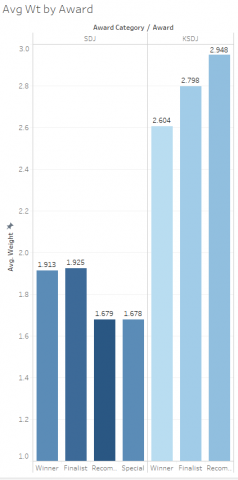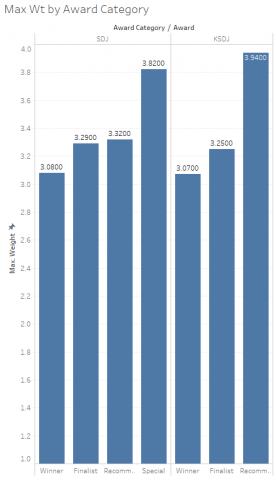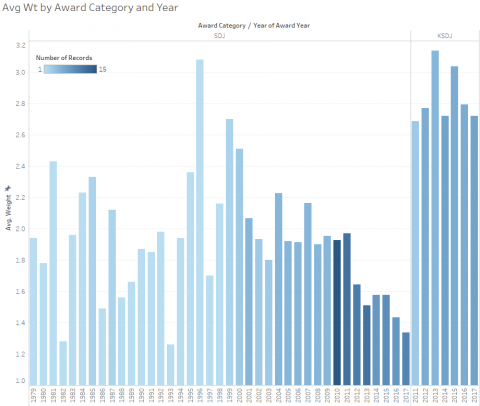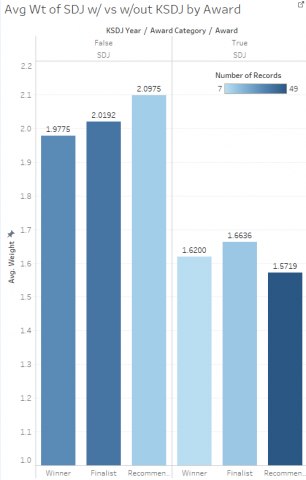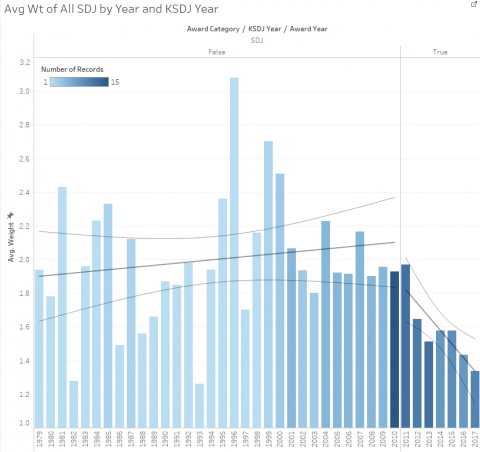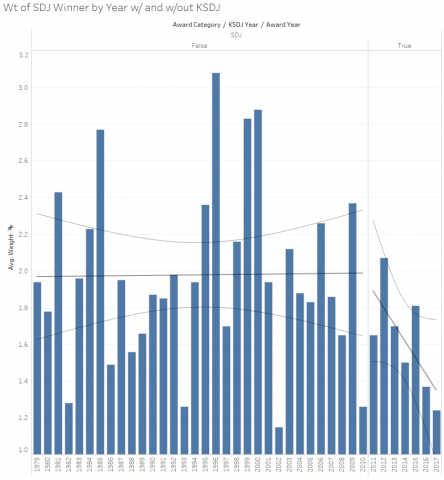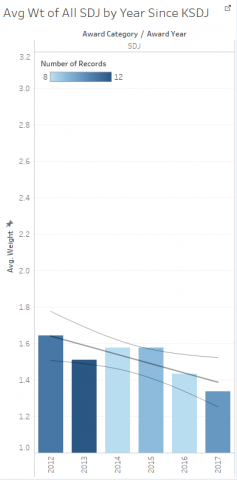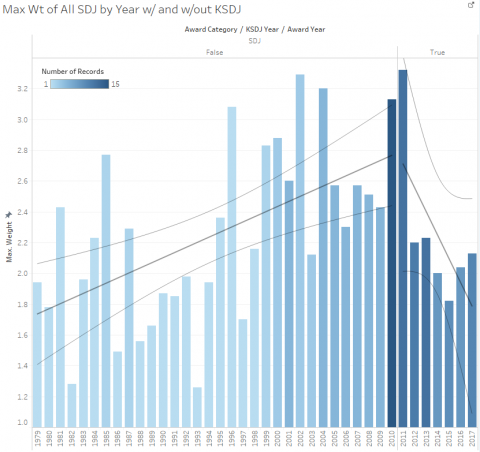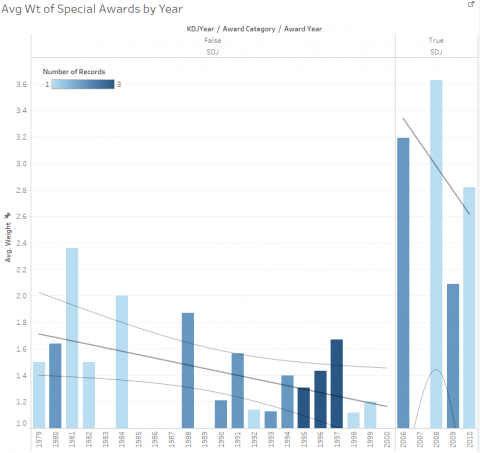The Full Weight of the Spiel des Jahres - Part 2
Setup
The Spiel des Jahres (SDJ) award is intended to recognize games for “family and friends.” Does it hit that mark? The Kennerspiel des Jahres (KSDJ) was created to recognize more advanced games. Anecdotally, this is obvious from the difference in games that have won the awards, but is there a way to quantify this difference? Not dissimilar from other media, the complexity level of a game is represented by what gamers generally call “weight,” which is available as a community contributed measurement on BoardGameGeek.com. All graphs have been derived from data obtained from BoardGameGeek.com in June and July 2017.
Let’s take a look at the weight of SDJ and KSDJ winners and nominees over the years for insight into their level of complexity:
- What are their average and relative weights?
- Have their weights changed over the years? (Are the games getting more or less complex?)
- Have there been major changes over the years? What were the likely events that caused these changes?
Note: If you are starting your reading with this article, you might want to jump to the introduction here: Spiel des Jahres & the BGG Community Part 1
Round 1: What does Weight Mean?
The BGG Weight rating is intended to quantify the complexity of a game, how difficult is it to learn and play – not to be confused with how difficult it is to win. The value reported for each game is based on community votes given the following recommended weights:
- Light
- Medium Light
- Medium
- Medium Heavy
- Heavy
Data Note: Although this is a 5 point scale, it is important to note that the lowest rating is 1.00 and the highest is 5.00, so there is really only a potential 4 point difference between the lightest and heaviest game ratings.
Round 2: Average and Relative Weights
First, let’s look at the average and relative weights of the games mentioned in the two awards. Note: This graph excludes the games given “Special” awards. We will look at them later. For the following graphs, the height of each bar represents its weight (also indicated with a number at the top) and the color of the bar represents the number of games included in the calculation for that bar.
The average weight of the SDJ games (winners, nominees, and recommended) is 1.826 – just under “Medium Light” and the average weight of the KSDJ games (winners, nominees, and recommended) is 2.836 – just under “Medium.” Neither of these ratings is surprising to me. The KSDJ games are a full point, 25% (if we can think of it that way) more complex than the SDJ games.
Now, let’s break the data down a bit further and look at the different statuses (winners vs. nominees, etc.). This time we will include the “Special” awards as well.
Although the difference is very small, I am surprised to see that the SDJ winners are a fraction more complex (+0.087 or 5%) than the average game considered for the award. The finalists represent the most complex games. The difference is greater for the KSDJ games, but in this case the winners are measurably less complex (-0.232 or 8%) than the average game in consideration. In this case, the recommendeds represent the most complex and winners the least.
So far we have been talking about averages, but since a main interest to the typical BGG user is heavier games, a look at the maximum weight for each award might be interesting.
Even if nothing has been surprising so far, this data should get your attention. First let’s look at the SDJ winners. The max weight of a winner (3.08, a solid “Medium”) is 1.167 heavier than the average (1.913, “Medium Light”). The difference for recommendeds is the greatest at 1.641 (3.32 vs. 1.679).
The difference for KSDJ winners is also large, but not as drastic, at 0.466 (3.07 vs. 2.604). As with the SDJ, the recommendeds represent the greatest difference at 0.992 (3.94 vs. 2.948). The heaviest game here, at 3.94 (a solid Medium Heavy weight), is very heavy in comparison to the general population of games on BGG. There are very few games on BGG with weights over 4.
The fact that the recommended games for each award show the greatest difference makes sense. These games were considered for the awards, but did not make the finalists; possibly because of their weight.
Given the great differences in the SDJ winners in particular, several questions arise:
- What games were these and when were these heavy games considered for the awards? (from left to right on the graph)
- SDJ Winner (1996): El Grande
- SDJ Finalist (2002): Puerto Rico
- SDJ Recommended (2011): Luna
- SDJ Special (2006): Caylus
- KSDJ Winner (2012): Village
- KSDJ Finalist (2017): Terraforming Mars
- KSDJ Recommended (2013): Terra Mystica
- Were these games just outliers or has there been a trend over time? We’ll look at that in the next section.
- What’s with the Special awards? They have the biggest difference at 2.142! We’ll look at the special awards in a section by themselves a little later, but will refer back to this graph.
Round 3: Weight Trends
First, let’s look at the average weight of games for each award by year (excluding Special awards).
First, a side note: As indicated by the color of the bars, the number of games considered and recognized in some way has grown significantly over the years. The SDJ jury is a busy organization these days.
As before, the difference in the average weight between the SDJ and KSDJ games is obvious, but let’s look a little closer. The KSDJ award is intended to recognize heavier games so it makes sense that the average weight of SDJ games would have dropped since the introduction of the KSDJ. Looking at the SDJ average weight for the years 2011 to 2017 this appears to be true and is verified in the following graphs showing the average weight of SDJ games in a year with a KSDJ award (True) and without (False).
OK, so this is no surprise, but it is validation of the SDJ jurors’ intent.
While the average weight of considered games was rising during the years leading up to the introduction of the KSDJ, it has dropped significantly since the KSDJ has been an option. (Excluding 2011, when it appears that the SDJ/KSDJ distinction was in transition, the awards show a distinct step down.)
However, throughout the SDJ award history, though the considered games were gaining in weight, the weight of the winner has been fairly consistent until the introduction of the KSDJ.
Even when eliminating the “transition year” (2011), there is a trend toward lower weight.
The trend is even more dramatic when looking at the maximum weight of games considered.
Not that the SDJ jurors need any justification for what they do, but this does show that more heavy games were considered, but were losing out to the Medium Light games.
Note: There are only 7 years since the KSDJ, so the data is easily skewed. It will take a few more years to see where the SDJ settles out in the post-KSDJ years.
Round 4: A Special Case
Finally, let’s look at the “Special” awards. Over the years the SDJ jurors have awarded “Special” awards to games that were not otherwise considered for the SDJ award. This practice appears to have stopped since the introduction of the KSDJ. A look at the weight of games given this award provides some insight into their history. Prior to the introduction of the Kennerspiel des Jahres (KDJ) award (the Children’s game), these awards tended to be Light games and the trend was lighter toward 2001 when the KDJ was introduced. Once the KDJ was introduced, the weight of games awarded the Special prize immediately jumped up to KSDJ weight games.
End Game
Although there are no major revelations in this analysis, based on the typical reference to the SDJ as only light games, it is a bit surprising to see the number of weighty games getting some love over the years – even before the KSDJ.
The SDJ jury appears to have responded to the changing tastes of their audience by introducing the Kinderspiel and Kennerspiel at times when the market had broadened for lighter and heavier games
Additional parts to this article are available here:
- Spiel des Jahres & the BGG Community - Part 1
- The Full Weight of the Spiel des Jahres - Part 2
- How do Spiel des Jahres Winners Rate? – Part 3
- Buy and Play Spiel des Jahres Games– Part 4
- What Makes an SDJ Winner? – Part 5
- The Impact of SDJ Consideration – Part 6
Your Turn
Do you ever use the BGG weight as a factor in deciding whether you are interested in a game? What is the typical weight of the games you like to play? Are that SDJ and KSDJ game weights surprising to you? Have you considered these awards in you game buying and playing interest? Does the data change your mind about your reliance on them?
Flavor Text
This is the data that I was originally collecting to analyze, so it is the best place to start. However, as I started digging into the data, I saw other factors that may provide interesting analysis and possible insight into these prestigious awards.


